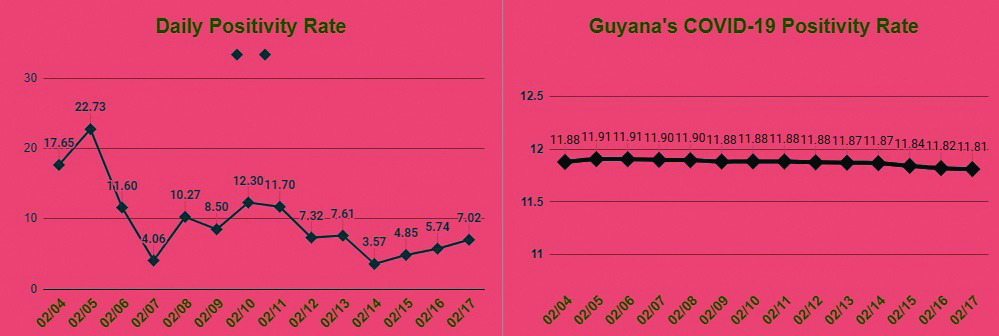Dear Editor,
This week Guyana surpassed 1200 deaths on February 16, about one month shy of the first death on March 11, 2020 two years ago. An analysis of the 1203 deaths (as of February 17) was done on the age groups most favoured by the Ministry of Health.
It was no surprise that the last grouping, 60+ (60 and older), held the largest share of deaths at 64.01%. It became clear during the pandemic that the elderly were at the greatest health risk (https://www.nytimes.com/2021/12/23/briefing/covids-risk-to-older-adults.html). However, Guyana is one of a few nations that use the 60+ age cohort. Most countries, including the US, use the 65+ grouping. In a NYT article of Dec 13, 2021, the heading read: “As U.S. Nears 800,000 Virus Deaths, 1 of Every 100 Older Americans Has Perished” but it was the sub-heading that was most revealing: “They are among the most vaccinated groups, but people 65 and older make up about three-quarters of the nation’s coronavirus death toll” (https://www.nytimes.com/2021/12/13/us/covid-deaths-elderly-americans.html).
The NYT found that people 65+ made up about 75% of the nation’s coronavirus death toll. Adjusting the analysis to look at the percentage of elderly Guyanese 65+ who died from the coronavirus led to: 52.29% of Guyanese 65+ dying from the virus (see below).
That is a far cry from the 75% in the US and elsewhere. Furthermore, the online site, WebMD states: “Age. Your chances of getting seriously sick with COVID-19 go up with your age. Someone who’s in their 50s is at higher risk than someone in their 40s, and so on. The highest risk is in people 85 and older. “ (Who is Most at Risk for Coronavirus (COVID-19)? (webmd.com)). This assertion is backed up by the data from the website Statista which shows that the 85+ age group with the highest deaths followed by the 75-84 age group then 65-74 age group (• COVID-19 deaths by age U.S. 2022 | Statista). However, this is not the case in Guyana. An earlier graph by this letter writer last month showed the reverse in Guyana: after peaking at the 60-69 age group there were successive decreases and not the increases one would have expected (https://www.stabroeknews.com/2022/01/20/opinion/letters/covid-19-deaths-shows-the-virus-to-be-relentless-across-all-age-groups/).
Obviously, Guyana is not the US but is there another explanation for this reversal of deaths in the elderly? Is this the result of ‘excessive deaths’? Superior care for the elderly both in private homes and in public geriatric homes? An extraordinary gene pool amongst Guyana’s elderly? One is reminded of the Stabroek News article on Zorie De Mattos, the oldest Guyanese survivor of COVID-19 (https://www.stabroeknews.com/2021/03/18/features/first-person-singular/the-miracle-of-ward-six/).
Another way of looking at the 52.29% is that almost half (47.71%) of those Guyanese who died are below the age of 65. Guyana is about to publicly observe its Republic status this week and many Guyanese below 65 will be celebrating en masse. In three months Guyana will be observing its Independence with thousands in the diaspora of all ages returning home for the festivities. Guyana, like many countries, has relaxed its coronavirus protocols. On the horizon possibly sits BA.2.
In another analysis of the 1200 deaths the charts below were generated. Respecting Stabroek News’ brevity in letter writing policy the entire chart (quite large) will not be shown here (it can be found elsewhere on the web). It is a chart that shows multiple hundreds of deaths and the number of days it took to reach that milestone. For example, the first chart shows the first 200 deaths of the pandemic: by way of explanation, it took 159 days for the first 25 deaths. 211 days for the first 100 deaths and 358 days for the first 200 deaths. The second chart shows the last 200 deaths: it took 37 days to get to 1000 from 900; 46 days from 1000 to 1100; and just 29 days from 1100-1200. Or in other words, 75 days for the last 200 deaths [The 29 days is the fourth fastest 100 deaths behind 800-900, 23 days; 600 to 700, 22 days; and 700-800, 19 days].
The 29 days are worrisome given that the last 100 deaths were achieved in 17 less days than the previous 100 deaths, and bring into question the relaxation of COVID protocols. Nevertheless, there are some encouraging signs: hospitalisations have decreased substantially, the patients in the ICU are now in single digits, the recovery rate is at an all-time high of 96.42%, and vaccinations continue to inch upwards, (albeit slowly). These factors give hope that Guyana is moving in the right direction of less deaths in the coming months.
But, it could all be for naught. With the public and indoor festivities accompanying the coming months of celebrations most of which will take place in the densely populated Region 4 and BA.2 (said to be 1.5 times more transmissible than Omicron, with some studies suggesting it might be more virulent) possibly lurking in the shadows Guyana could be in for a deja vu surge in infections and more deaths. While the daily positivity rates (shown below) have decreased there hasn’t been enough testing to significantly impact the very high total rate [testing has decreased 34.09% in the last two weeks and 62.35% since January 21, the peak of testing during the surge; this record breaking testing was chronicled (https://guyanachronicle.com/2022/01/21/over-55000-covid-19-tests-conducted-so-far-for-january/)] which now stands at 11.81% (up from a low of 9.31% on December 30, 2021) and has been in the 11% range since January 17. The 11.81% positivity rate is more than twice the WHO recommendation of 5% or lower for a return to ‘normal’.
Perhaps this is not the time to lower mitigations against the spread of this seemingly wily virus.
Yours faithfully,
Ellis Dee










